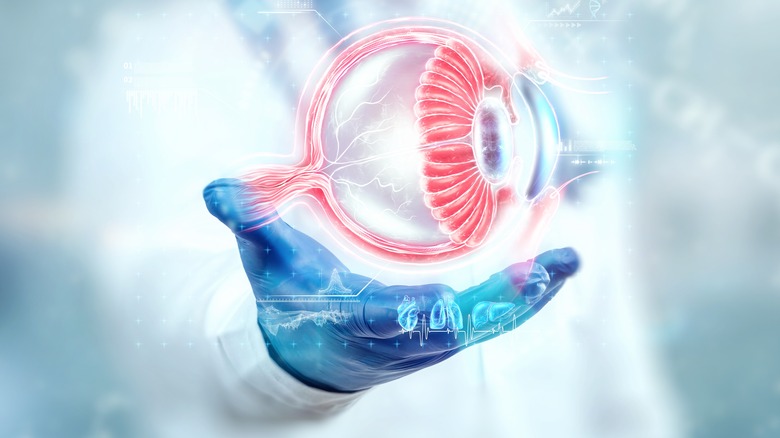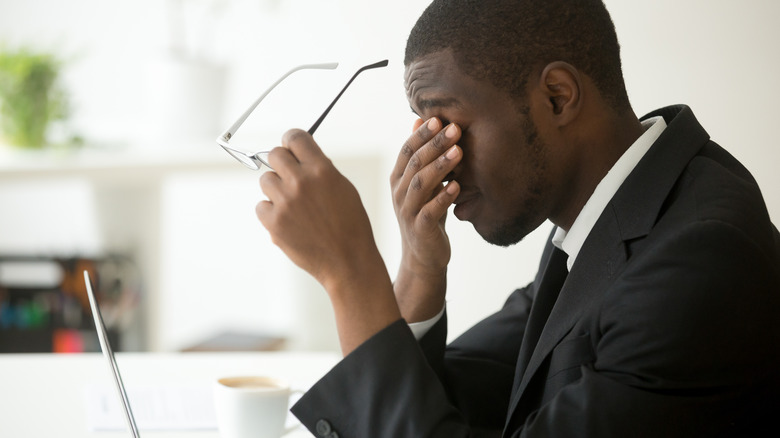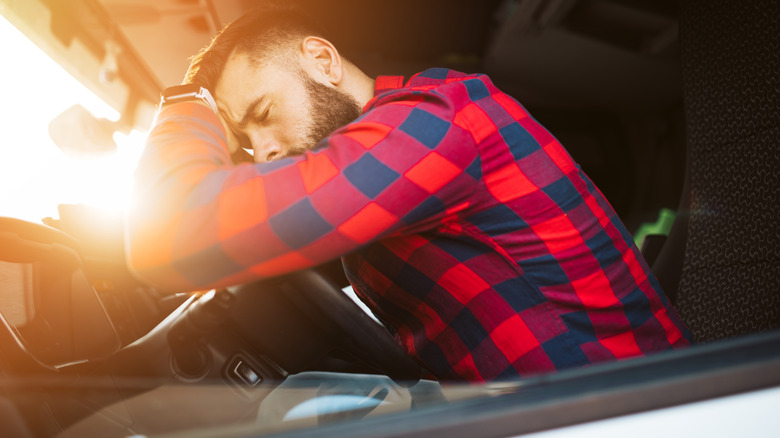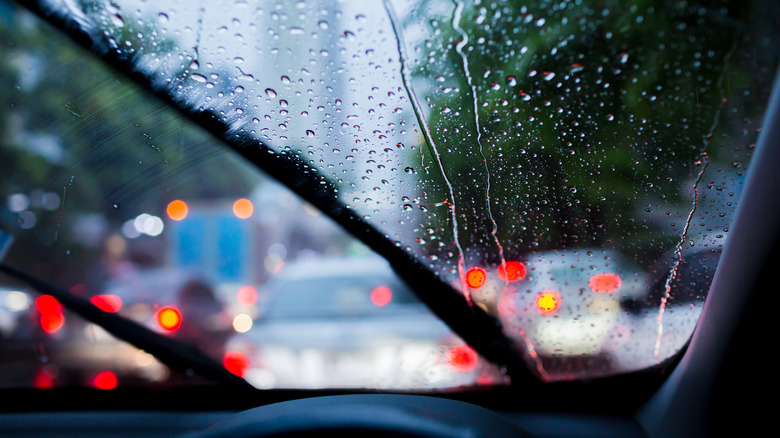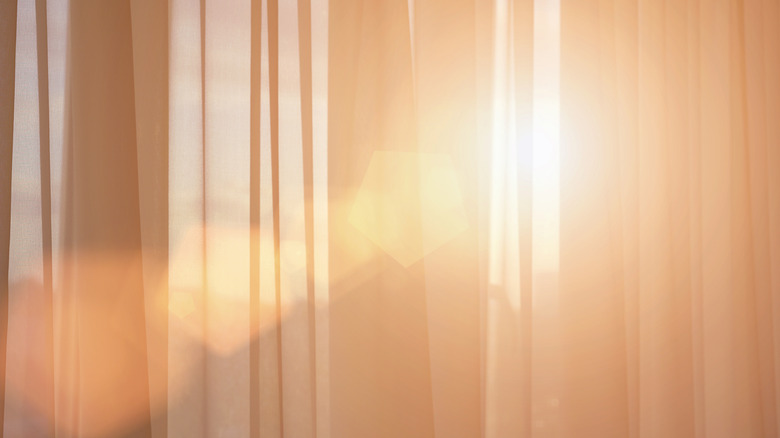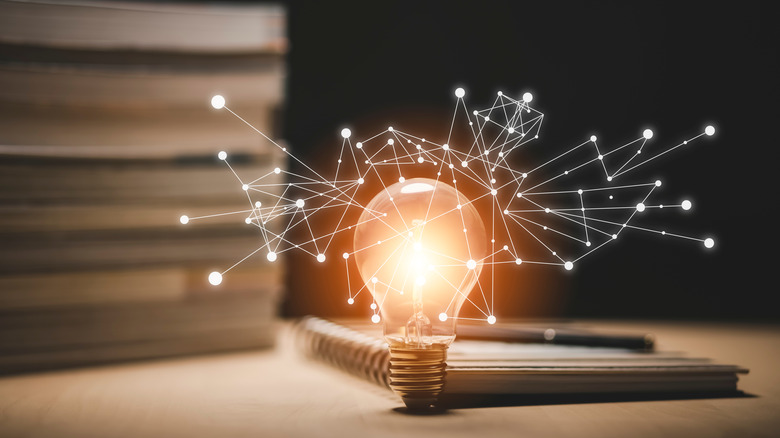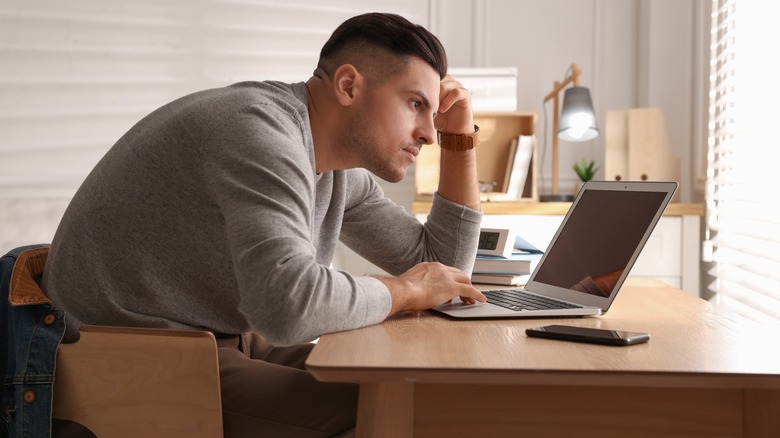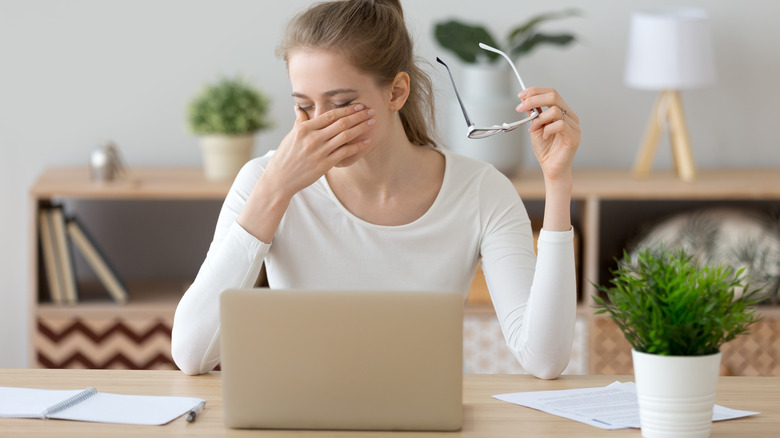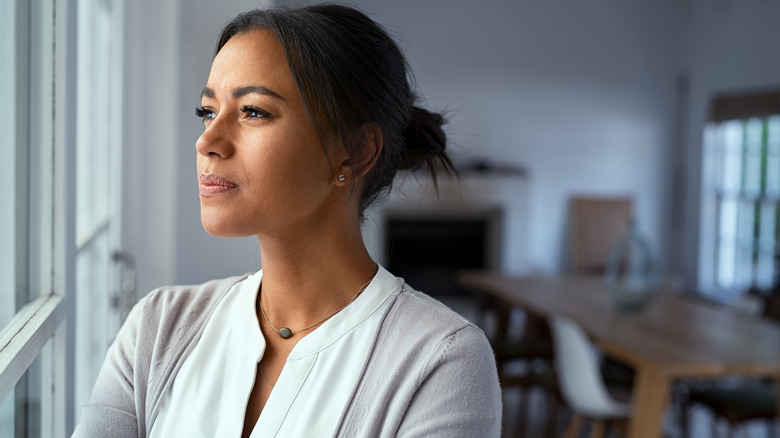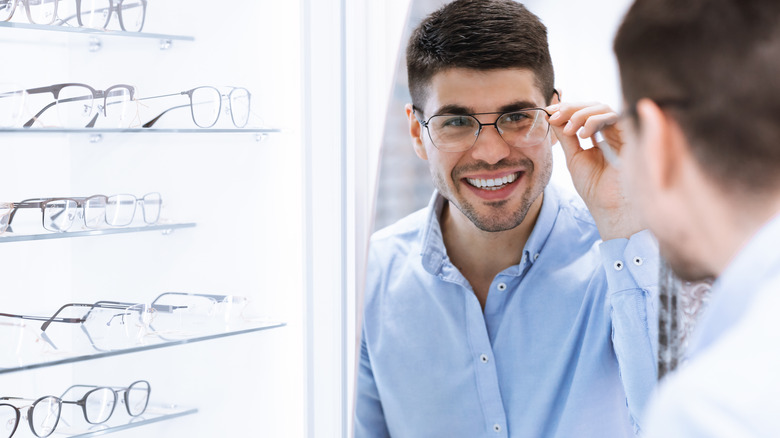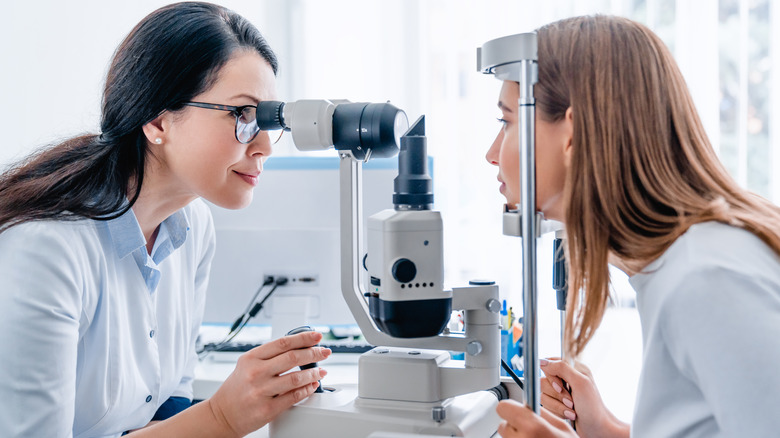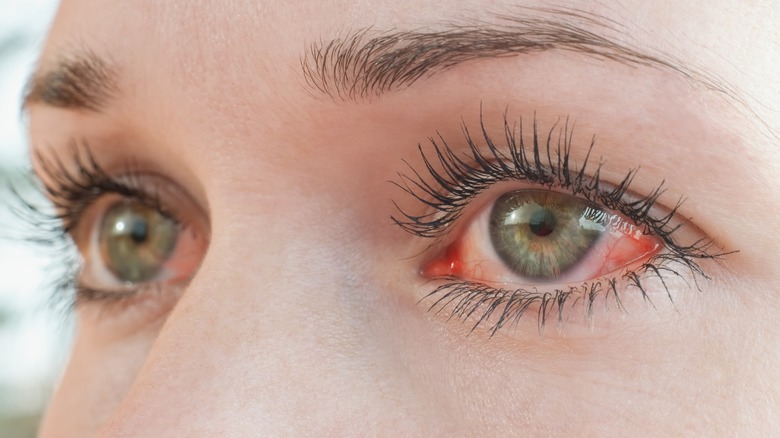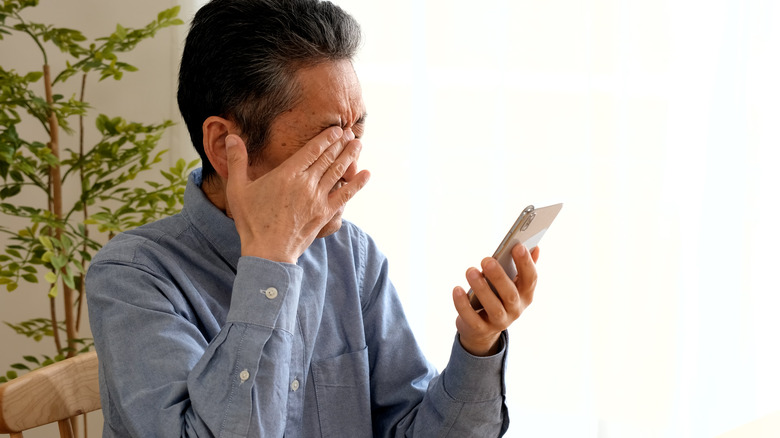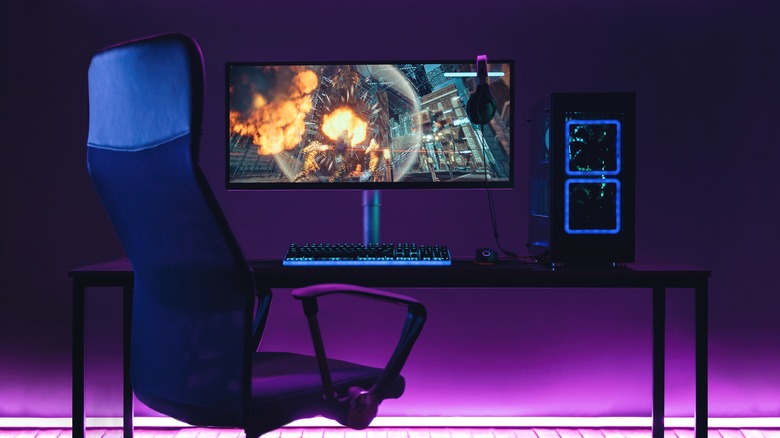Eye Strain Explained: Causes, Symptoms, And Treatments
When you look at things, the muscles in your eyes make your pupils smaller for the stuff you look at up close and larger for far away focus. Quickly moving between the two makes the muscles exert extra effort. Like other hard-working muscles, they need time to rest (via NVISION Eye Centers).
Medically referred to as asthenopia, eye strain was first reported at the 45th Annual Meeting of the American Medical Association in 1894. At the time, Dr. C.M. Hobby compared this condition to indigestion (dyspepsia) and explained that symptoms occur after "prolonged use of vision at short range." At the time, reading and sewing for an extended period were considered the main culprits.
Today, medical professionals at the Mayo Clinic define asthenopia as tired eyes or eye strain that occurs when you use your eyes intensely for an extended period. Doctors at the Cleveland Clinic add driving and using digital devices to the list of causes of eye fatigue, particularly if done in poor lighting or with an undiagnosed eye issue.
Computer vision syndrome
The most common modern cause of eye strain is using digital devices. More than 80% of adults in America use a computer, phone, or another digital device for more than two hours daily. Moreover, close to two-thirds of users report working on two or more machines simultaneously, and nearly the same amount say they have at least one eye strain symptom (per The Vision Council).
Using a computer, tablet, e-reader, or cell phone for an extended time can lead to what the American Optometric Association (AOA) refers to as computer vision syndrome (CVS) or digital eye strain. This ailment results in problems focusing, pain in and around your eyes, and discomfort in your head, shoulders, and neck, according to the American Academy of Ophthalmology (AAO).
Harvard Business Review cites muscle fatigue due to long-term focusing as one cause of CVS. "We don't blink as much when using screens," Dr. Joshua L. Dunaief, associate professor of ophthalmology at the University of Pennsylvania's Scheie Eye Institute, told NBC News, "because the blink response is suppressed. So we don't spread tears across our eyes and they wind up drying out." And this leads to CVS.
Driving and eye strain
Driving puts a great deal of stress on your eyes. They must work to focus while moving toward and away from objects. All this exertion can cause eye strain (per The Vision Council). Additionally, sun glare during the day, dark streets, and bright headlights at night only add to the problem (via Baylor College of Medicine).
Additionally, if you work on a computer and have CVS, your eyes will be further strained while driving, which can lead to blurry vision. If you can't see clearly due to eye strain, your depth perception gets skewed, and you have difficulty seeing road markers (per Bankrate).
Medical professionals at Baylor College of Medicine recommend wearing sunglasses during the day and glasses with no-glare polarized lenses to lessen the glare at night. In addition, truck drivers often wear polarized safety glasses to help contend with the eye strain that often accompanies looking at bright sunlight hitting black asphalt (via SafetyGlassesUSA.com).
Today's Trucking recommends getting an eye exam, modifying your work habits, blinking often, and turning the vents in your vehicle away from blowing directly into your face and drying out your eyes.
Refractive errors and their relation to eye strain
The Centre for Eye Research Australia defines refractive error as vision made unclear due to light improperly focusing on your retina in the back of your eye. According to The National Eye Institute, more than 150 million Americans have one of four main types of refractive errors. They are nearsightedness (blurs objects at a distance), farsightedness (obscures close things), astigmatism (clouds stuff both near and far), and presbyopia (inability to see in dim lighting).
Myopia results from a curved cornea or having a longer than normal eyeball. Hyperopia results from a short, flat cornea. An oval-shaped cornea or lens causes astigmatism. Presbyopia happens because your eye cannot bend light correctly (via Better Health Channel). Refractive errors can cause your eyes to become strained and feel tired, sore, or dry. Headaches may accompany these issues.
Doctors check for refractive issues during a comprehensive eye exam which may include reading letters off a board and special drops that dilate your pupils. Treatment options include glasses, contacts, and laser eye surgery (via The National Eye Institute).
Glare and eye strain
Glare occurs when light is so bright it causes you to have a hard time seeing. According to the medical professionals at Versant Health, glare results from more light entering your eyes than they can handle. Glare occurs day and night and either comes directly from a light source or is caused by reflected light. Either way, glare can range from being a mild disruption to hazardous.
News24 reports that glare results from contrast, or the brightness variation between what you are looking at and its surroundings. Glare often occurs when you look at something bright among the darkness, causing your eyes to strain.
There are several types of glare. Distracting glare is from a reflection and often causes a halo effect around light sources at night. Bright sunlight causes discomforting glare and makes you squint or turn away. Disabling glare changes the contrast of what you are looking at and most often stems from looking directly into a light source. Blinding glare happens when light gets reflected off a shiny surface and blocks your vision (per Versant Health). Finally, screen glare occurs due to screen brightness and the light reflected off your screen from the light sources in the room (via Nature's Best).
How lighting causes eye strain
While light enables your eyes to create the visions you see, too much and too little can result in eye strain (per Massachusetts Eye Associates). So, in addition to avoiding glare, the medical professionals at Vision Pro Optical recommend you reduce your exposure to fluorescent lights to lower your chances of developing eye strain.
Many offices use fluorescent lights both overhead and as energy-efficient replacements for incandescent bulbs. Regardless of their placement, this lighting emits artificial ultraviolet (UV) light. Overexposure results in eye strain and can cause cataracts and age-related macular degeneration, especially if you have light-colored eyes, as darker-colored eyes have more protective pigment (via Vision Pro Optical). Additionally, studies show that as you age, more light is required to avoid eye strain. "The research shows that a 60-year-old needs almost twice as much light to see as a 30-year-old" (via Vision Source).
The doctors at Massachusetts Eye Associates recommend using softer lighting from less intense bulbs or allowing more natural light into the room. According to Vision Source table lamps and task lighting also helps reduce eye strain.
Poor posture and eye strain
The Optometrists Network reports that nearly 70% of people will have neck pain that disrupts their lives, including causing eye strain. Tight muscles in your neck may push on the nerves in the back that lead to your eyes. Tense muscles can be caused by a head tilt compensating for a common visual misalignment known as Binocular Vision Dysfunction. Binocular Vision Dysfunction results from a mispositioning of your eyes, making it so clear images don't reach your brain.
Furthermore, according to Think Healthy, technology has caused people to change how the head rests on the neck. Today, more than two-thirds of the population maintains a forward head posture. In doing so, your upper back and neck muscles must work harder to prevent your head from falling over, and pressure is put on the nerves in your spinal cord, including your optic nerve. Moreover, slouching decreases your circulation resulting in the need for you to move your head to see clearly.
Since your head weighs over 10 pounds, it's best to stop hunching over the technology you use (per A.Vogel). Instead, the medical professionals at Dr. Bishop & Associates recommend seeing a vision specialist and changing how you sit and stand.
Dry eye's relation to eye strain
Dry eyes cause your eyes to feel itchy, scratchy, and irritated. Other symptoms include having your eyes feel hot, like you have something in them, or they become watery. Dry eyes can also blur vision (per Stanford Health Care).
Just under 20 million American adults suffer from dry eye disease. Though it is not caused by eye strain, it certainly doesn't help. This is especially true if technology is the cause of your eye strain (per Medical Optometry America). In fact, a BMJ Open Ophthalmology study reports that the prevalence of dry eyes jumped from just over 50% to 75% for those that use more than one device at a time.
One of the leading causes of dry eye with eye strain, specifically when computers are involved, is decreased blinking. Participants blinked much less while staring at a screen. Authors believe that the reduction in blinking is due, in part, to involuntary squinting to reduce glare and improve clarity (via BMJ Open Ophthalmology).
Blinking spreads tears that keep your eyes damp (per Optometrists Network). And blinking less enables the liquid in your eyes to evaporate more quickly without replenishment (via Medical Optometry America).
Stanford Health Care reports other causes of dry eye include dry weather, smoke, pollution, allergies, contact lens use, age, and other medical conditions.
Headaches caused by eye strain
Looking at a screen or intensely focusing on an object for an extended period can cause your eye muscles to work harder. Like the other muscles in your body, the muscles in your eyes can get tired and painful from overuse. Add to that any squinting, and you get eye strain and a headache, as well (per Healthline).
In fact, according to African Vision and Eye Health, more than 40% of those diagnosed with eye strain complained of headaches, making it the most common symptom.
Healthline reports several subtle differences between regular headaches and those associated with eye strain. First, an eye strain headache only occurs after using your eyes for a while and gets better after you rest them for a bit. Also, the pain associated with an eye strain headache occurs around your eyes and isn't accompanied by nausea or vomiting.
If you suffer from frequent headaches associated with eye strain, Dr. Michael Callahan, ophthalmologist at UAB Callahan Eye Hospital, recommends seeing an eye doctor to rule out the need for glasses or the diagnosis of another medical condition, including allergies, infections, and glaucoma.
20-20-20 rule to reduce eye strain
The American Academy of Ophthalmology (AAO) recommends that for every 20 minutes you use a screen, you look at something 20 feet away for 20 seconds. If you're not sure exactly how far 20 feet is, the medical professionals at Advanced Eye care & Aesthetics recommend finding something far away to look at for the 20 seconds it takes for your eyes to relax. If you can't remember to look elsewhere, you can set a reminder or the timer on your phone. You can also download an app like Eye Care 20 20 20 or Donald Korb Blink Training.
A study done by Contact Lens and Anterior Eye shows that participating in the 20-20-20 rule had several benefits. First, during the breaks, blinking increased from 8-9 per minute to approximately 20. Also, thanks to the reminders, the number of pauses included in the study went from 27 to 34. Moreover, participants also became more mindful of their computer usage and cut down on the amount of time they were on devices continually. This was even though they initially overestimated their computer usage, stating they use technology for seven hours daily. In actuality, when survey takers included breaks, it was closer to four.
Eyewear and its effect on eye strain
According to Dr. Daryl Berger, eyestrain could be the first sign that you need glasses or contact lenses. It could also indicate that your current prescription needs fixing. The Eye Place recommends having your eyes tested every two years to ensure your corrective eyewear fits you and your current situation and prevents sore eyes.
Those who tested initially with perfect vision may find a need for reading glasses for up-close activities. The medical professionals at Banton Frameworks state that this is the first sign your vision is starting to wane. Reading glasses, which magnify what you're looking at, also help those waiting to see their eye doctors for an exam as they reduce eye muscle workload in the short term. In addition, single-vision lenses help correct common eye problems and reduce headaches associated with eye strain from computer use and reading.
However, the doctors at Downtown Eyes warn that glasses aren't an instant fix for eye strain because your eyes need time to adjust. In fact, if you are wearing glasses for the first time or your prescription changes drastically, you may have a headache for a few days because your eyes are working harder than ever. This is especially true with bifocals, trifocals, or progressives. If the discomfort doesn't go away, have your glasses adjusted or see if you can get different ones.
Doctors to see for eye strain
It's essential to see an eye doctor before you have a problem like eye strain. However, the Centers for Disease Control and Prevention (CDC) reports that less than 40% of children in preschool have undergone an eye exam, and only around half of the nearly 100 million adults in the United States at risk for vision loss have seen an eye doctor in the last year. So before you visit an eye care professional, you must decide which of the three types is best for you.
All About Vision recommends you start with one of the 44,000 optometrists currently practicing in the U.S., as they are considered primary care physicians for your eyes. Also, doctors of optometry are professionals who diagnose and treat common eye problems and help to keep your vision clear.
Ophthalmologists treat more complex issues. These eye specialists complete at least 12 years of education and training before being licensed. As doctors, ophthalmologists not only diagnose and treat all eye diseases, they also perform eye surgery and write prescriptions. Additionally, their medical training enables them to diagnose health issues not directly associated with your eyes (per American Academy of Ophthalmology).
According to the American Association for Pediatric Ophthalmology & Strabismus (AAPOS), an optician is an eyewear technician. Opticians are trained to ensure your glasses, frames, and contact lenses fit correctly. These professionals do not perform tests, write prescriptions, or diagnose or treat eye problems. Instead, they use those provided by ophthalmologists and optometrists.
When to see a doctor for eye strain
In a report released by Study Finds, more than one-third of those questioned said they'd give up using the internet for one year to improve their eyesight. However, one in eight of the same group of people have never seen an eye doctor, nearly two-thirds work through eye strain pain — and almost 80% have to force themselves to take breaks to address the discomfort.
If you are similar to approximately half of those questioned and have canceled plans or called out sick, it may be time to see a doctor (per Study Finds). Medical professionals at The Eye Practice recommend making an appointment with an ophthalmologist or optometrist if your eye strain symptoms don't go away after you stop the offending tasks.
The doctors at Bright Eyes Optometry recommend seeing an eye care professional if your eye strain is coupled with blurred or double vision and persistent or migraine headaches. Furthermore, those at the Mayo Clinic advise you seek immediate medical attention if your eye strain symptoms include a severe headache with light sensitivity or halos, swelling, or the inability to open your eyes.
Complications if eye strain is left untreated
The Mayo Clinic states that eyestrain doesn't cause severe or long-term issues. However, the problems it does cause can be tiresome and not only cause discomfort but also make it difficult for you to concentrate. In addition, complications related to eye strain often get aggravated by other obstacles, including screen usage and other untreated vision problems.
Of the issues that it does cause, VibraxLabs reports that 90% of them can be prevented by using proper lighting, having your screen at a comfortable distance, and taking breaks.
Additionally, according to Healthline, any related eye strain symptoms, including headache, dry eyes, and neck or shoulder pain, should dissipate quickly after stopping the activity that caused them to occur. However, discomfort that lasts more than a few hours may indicate another issue that needs medical attention.
Furthermore, because dry eyes are associated with eye strain, treating the accompanying symptoms increases your quality of life and helps decrease your risk of eye inflammation, corneal surface abrasion and ulcers, and vision loss (per Mayo Clinic).
Does blue light cause eye strain?
Electromagnetic energy is used all of the time to do things like watch TV and heat leftovers in the microwave (per NASA). Healthline explains that electromagnetic energy is transmitted in mostly invisible waves. One of the most common visible lights is blue light. It comes from the sun, most lightbulbs, and many of the digital devices used daily.
While a report in Molecular Vision points out that more long-term studies need to be performed, the American Journal of Ophthalmology reports that using lenses that block blue light didn't prevent eye strain or any related symptoms.
Additionally, Wilmer Eye Institute ophthalmologist Esen K. Akpek told Johns Hopkins University, "Blue light is not a cause of eyestrain. The natural crystalline lens and the cornea of the eye are able to block excessive blue light."
However, while blue light doesn't directly harm your eyes, the American Academy of Ophthalmology cautions that it can affect your circadian rhythm and change your sleep-wake cycle. Therefore, they recommend limiting screen time and using night or dark mode to minimize sleep-related problems and the eye strain that results from lack of slumber.

